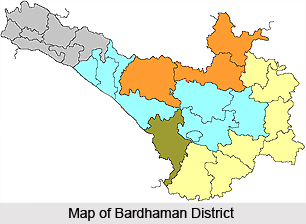 Bardhaman district is a district located in West Bengal. The main town of the district is Bardhaman. Bardhaman District covers an area of 7024 square km, and has a population of 6,895,514 (as per the 2001 census). The Birbhum and the Murshidabad districts, on the east by the Nadia District, on the southeast by the Hooghly District, on the southwest by the Bankura and the Purulia districts, and on the northwest by the state of Jharkhand, surround it on the north. The district consists of six sub- divisions, namely Asansol Sadar (North), Sadar (South), Durgapur, Kalna, and Katwa. It was among the first districts to have a 100% literacy rate.
Bardhaman district is a district located in West Bengal. The main town of the district is Bardhaman. Bardhaman District covers an area of 7024 square km, and has a population of 6,895,514 (as per the 2001 census). The Birbhum and the Murshidabad districts, on the east by the Nadia District, on the southeast by the Hooghly District, on the southwest by the Bankura and the Purulia districts, and on the northwest by the state of Jharkhand, surround it on the north. The district consists of six sub- divisions, namely Asansol Sadar (North), Sadar (South), Durgapur, Kalna, and Katwa. It was among the first districts to have a 100% literacy rate.
History of Bardhaman District
Barddhaman is located on the banks of the Damodar River, the town of Bardhaman is the district headquarters. It was named after the 24th Jain monk, Tirthankar Mahavira Bardhaman. During the Mughal rule, its name used to be Sharifabad. In the 17th-18th century, Raja Krishnaram Ray, belonging to a merchant family from Punjab, established the zamindari of Bardhaman on a farman issued by the Mughal Emperor Aurangzeb. The Rays went on to rule Bardhaman till 1955. From Bardhaman District there are various relics of Stone Age have been found in and they are similar to the finds of the stone weapons and other relics discovered in Singhbhum, Purulia, Dhanbad and Bankura districts. One of the totems of the Bauris who were the original inhabitants of Barddhaman and are stiff a formidable so-called lower caste has dog as their totem. The Bauris are supposed to be rough and rude. A large number of stone images of the different Tirthankar have been discovered in Burdwan district.
Burdwan was enriched with the art and culture of Gupta age and during the rule of the Sena kings also Bardhaman District was flourished. During the medieval period, Burdwan was an important administrative headquarters. It is here that Sher Afghan, the unfortunate husband of Nurjehan lived as a Jagirdar. Jehangir was anxious to bring over Nurjehan to his harem and had deputed Kutubuddin to Burdwan as his Subedar.
Ultimately both Sher Afghan and Kutubuddin were killed in a fight somewhere near the present Burdwan railway station. The two graves of Sher Afghan and Kutubuddin lying side by side in Burdwan not only recall history but remind rudely as to what man can do to satisfy his lust. It is again Bardhaman that gave sanctum to the intellectual and spiritual divine, Pir Baharam when he had to leave Delhi due to the machinations of Abul Fazal and Faizi in Akbar`s time. A Hindu divine Jaipal came in close touch with Pir Baharam land both enjoyed a mutual spiritual companionship. Bardhaman witnessed, experienced and survive numerous violent conflicts and is visited and dominated by the notables for ages. From Raja Todarmal to Daud Karnani, from Sher Afgan and Qutbuddin to Ajimuswan and even Shah Jahan, when he was still a rebel, had dominated the region, which makes it a land of multi faceted cultural legacy. The temples (deuls, mainly of rekh variety) here embody the Buddhist culture. Various mosques and mandirs (old Hindu temple) bear the signs of Muslims and Hindu Culture at the same time. The Hindu mandirs are mainly the symbols of the Vaishnava and Sakta community.
Geography of Bardhaman District
Bardhaman District is the most resourceful district in West Bengal both technologically and agriculturally. The eastern part of the district is enhanced by the alluvial soil of the river Bhaghirathi (a minor stream of the Ganga River). It is one of the most fruitful agricultural areas in West Bengal. The western part of the district, primarily Asansol, is affluent in coal and other mineral resources. This part is greatly industrialised and consists of a range of factories based on iron and steel processing, as well as many cement factories. The towns of Durgapur, Burnpur, and Kulti are in the western part of the district. In the districts are also located power plants, in the towns of Durgapur and Dishergarh.
Tourism of Bardhaman District
Some of the tourist spots of Bardhaman District are Curzon Gate, 108 Shiva Mandirs, Tomb of Sher Afghan, Golapbag, Hawa Mahal, Ramana Bagan, Bijoy Bahar, Meghnad Saha Planetarium, Sarbamangala Temple, Kankelshwari Kalibari, Kalna and Maithon.






